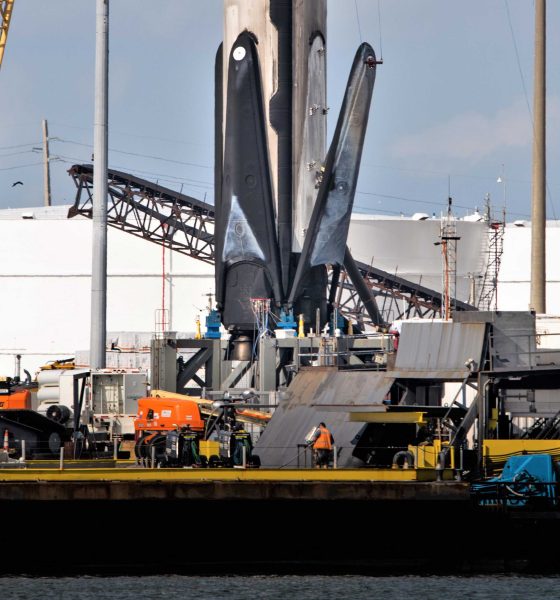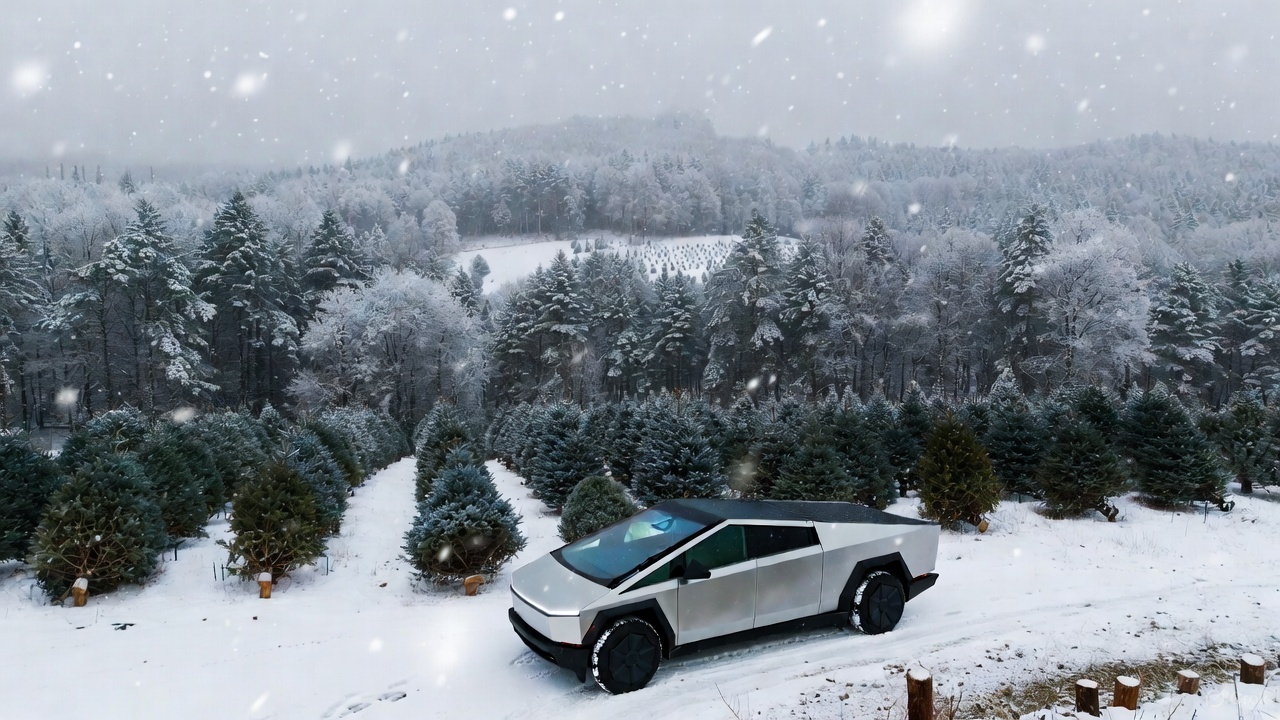

News
SpaceX hits new Falcon 9 reusability milestone, retracts all four landing legs
SpaceX appears to have selected Falcon 9 B1056 to become the first booster to have all four landing legs retracted and stowed. While relatively minor in the scope full Falcon 9 booster reuse, in-situ leg retraction could save SpaceX days of recovery and preflight work, a big help for truly rapid reusability.
A handful of prior retraction attempts have been made on Block 5 boosters but unknown issues prevented the process from taking hold. With some modifications to the legs and their deployment/retraction mechanisms, SpaceX seems to have solved those issues and is ready to graduate to a new level of rapid and easy rocket reusability. Teslarati photographer Tom Cross was on site in Port Canaveral, Florida when SpaceX began its first operational leg retractions and was able to capture photos and videos of the process.
Falcon 9 doesn’t even lift
The crux of the need for a relatively complex crane-and-jig method of leg retraction rests on SpaceX’s landing leg design. Put simply, after rapidly deploying with a combination of gravity and hydraulics, Falcon 9 landing legs have no built-in way to return to their stowed state. Each of the four legs are quite large, weighing around 600 kg (1300 lb) and stretching about 10m (33 ft) from hinge to tip. They use an intricate telescoping carbon fiber deployment mechanism to give the legs enough strength to stand up to the forces of Falcon 9 booster landings.
Combined, the legs’ size and telescoping mechanism makes the addition of an onboard retraction mechanism impractical. All the needed hardware would struggle to find a good place for installation and would quite literally be dead weight during launches and landings, stealing from Falcon 9/Heavy payload capacity and generally serving no purpose until a booster has been lifted off the ground with a giant crane.

As a result, SpaceX engineers instead decided to separate leg retraction hardware from the rocket itself and designed a custom crane jig. Pictured above, the jig attaches to Falcon 9’s interstage and allows the crane operator to lift the entire booster as needed. It also features four independent motors and pulleys that are meant to attach to a specific port on the outside of each booster landing leg. The jig then lifts the landing legs up, nominally retracting the telescoping deployment mechanism, at which point latches should be able to safely secure the legs to the booster’s body.
This has been significantly more difficult than expected, judging from a number of retraction attempts over the past six or so months. Falcon 9 Block 5 debuted in May 2018 – in fact, almost exactly one year ago – and SpaceX has since built 11 boosters that have supported 15 launches. SpaceX has thus taken ~12 months to get to a point where Falcon 9’s landing legs can be safely retracted, perhaps owing more to the fact that said legs are of minimal monetary value relative to the rest of a recovered booster. Improving leg retractibility is a bit of a luxury in that sense, as retracting legs offers little value proposition in terms of significantly lowering the cost of launch or reuse.


What leg retraction does do, however, is shave a significant amount of time off of the process of booster recovery and post-recovery processing. Instead of the normal process of totally dismantling and removing the legs piece by piece, stowing Falcon 9’s legs saves not only the time it takes to remove them but also the time it then takes to reinstall said legs for the next launch. At a minimum, this could save 12-24 hours of dedicated work, up to as much as several days according to CEO Elon Musk. Taken to the extreme, it’s likely that SpaceX’s ultimate goal is to lift a booster off the drone ship, retract its landing legs mid-air (or close), flip the booster horizontal, and lower it onto a transporter in one fluid movement.
If SpaceX can arrive at something approximating that in the near future, the company will be well on its way accomplish Musk’s goal of launching the same Falcon 9 booster twice in ~24 hours. Even further down the road, if or when SpaceX manages to optimize the reusability of its Falcon 9 boosters to the extent that almost zero refurbishment or in-depth inspection is needed between launches, minimizing the amount of human effort that goes into something as basic as preparing landing legs may actually have a significant impact on launch costs. For the time being, we get to enjoy the new and unusual spectacle of a giant reusable booster carefully stowing its landing legs for another launch attempt.
Check out Teslarati’s Marketplace! We offer Tesla accessories, including for the Tesla Cybertruck and Tesla Model 3.

Elon Musk
Starlink passes 9 million active customers just weeks after hitting 8 million
The milestone highlights the accelerating growth of Starlink, which has now been adding over 20,000 new users per day.

SpaceX’s Starlink satellite internet service has continued its rapid global expansion, surpassing 9 million active customers just weeks after crossing the 8 million mark.
The milestone highlights the accelerating growth of Starlink, which has now been adding over 20,000 new users per day.
9 million customers
In a post on X, SpaceX stated that Starlink now serves over 9 million active users across 155 countries, territories, and markets. The company reached 8 million customers in early November, meaning it added roughly 1 million subscribers in under seven weeks, or about 21,275 new users on average per day.
“Starlink is connecting more than 9M active customers with high-speed internet across 155 countries, territories, and many other markets,” Starlink wrote in a post on its official X account. SpaceX President Gwynne Shotwell also celebrated the milestone on X. “A huge thank you to all of our customers and congrats to the Starlink team for such an incredible product,” she wrote.
That growth rate reflects both rising demand for broadband in underserved regions and Starlink’s expanding satellite constellation, which now includes more than 9,000 low-Earth-orbit satellites designed to deliver high-speed, low-latency internet worldwide.
Starlink’s momentum
Starlink’s momentum has been building up. SpaceX reported 4.6 million Starlink customers in December 2024, followed by 7 million by August 2025, and 8 million customers in November. Independent data also suggests Starlink usage is rising sharply, with Cloudflare reporting that global web traffic from Starlink users more than doubled in 2025, as noted in an Insider report.
Starlink’s momentum is increasingly tied to SpaceX’s broader financial outlook. Elon Musk has said the satellite network is “by far” the company’s largest revenue driver, and reports suggest SpaceX may be positioning itself for an initial public offering as soon as next year, with valuations estimated as high as $1.5 trillion. Musk has also suggested in the past that Starlink could have its own IPO in the future.
News
NVIDIA Director of Robotics: Tesla FSD v14 is the first AI to pass the “Physical Turing Test”
After testing FSD v14, Fan stated that his experience with FSD felt magical at first, but it soon started to feel like a routine.

NVIDIA Director of Robotics Jim Fan has praised Tesla’s Full Self-Driving (Supervised) v14 as the first AI to pass what he described as a “Physical Turing Test.”
After testing FSD v14, Fan stated that his experience with FSD felt magical at first, but it soon started to feel like a routine. And just like smartphones today, removing it now would “actively hurt.”
Jim Fan’s hands-on FSD v14 impressions
Fan, a leading researcher in embodied AI who is currently solving Physical AI at NVIDIA and spearheading the company’s Project GR00T initiative, noted that he actually was late to the Tesla game. He was, however, one of the first to try out FSD v14.
“I was very late to own a Tesla but among the earliest to try out FSD v14. It’s perhaps the first time I experience an AI that passes the Physical Turing Test: after a long day at work, you press a button, lay back, and couldn’t tell if a neural net or a human drove you home,” Fan wrote in a post on X.
Fan added: “Despite knowing exactly how robot learning works, I still find it magical watching the steering wheel turn by itself. First it feels surreal, next it becomes routine. Then, like the smartphone, taking it away actively hurts. This is how humanity gets rewired and glued to god-like technologies.”
The Physical Turing Test
The original Turing Test was conceived by Alan Turing in 1950, and it was aimed at determining if a machine could exhibit behavior that is equivalent to or indistinguishable from a human. By focusing on text-based conversations, the original Turing Test set a high bar for natural language processing and machine learning.
This test has been passed by today’s large language models. However, the capability to converse in a humanlike manner is a completely different challenge from performing real-world problem-solving or physical interactions. Thus, Fan introduced the Physical Turing Test, which challenges AI systems to demonstrate intelligence through physical actions.
Based on Fan’s comments, Tesla has demonstrated these intelligent physical actions with FSD v14. Elon Musk agreed with the NVIDIA executive, stating in a post on X that with FSD v14, “you can sense the sentience maturing.” Musk also praised Tesla AI, calling it the best “real-world AI” today.
News
Tesla AI team burns the Christmas midnight oil by releasing FSD v14.2.2.1
The update was released just a day after FSD v14.2.2 started rolling out to customers.

Tesla is burning the midnight oil this Christmas, with the Tesla AI team quietly rolling out Full Self-Driving (Supervised) v14.2.2.1 just a day after FSD v14.2.2 started rolling out to customers.
Tesla owner shares insights on FSD v14.2.2.1
Longtime Tesla owner and FSD tester @BLKMDL3 shared some insights following several drives with FSD v14.2.2.1 in rainy Los Angeles conditions with standing water and faded lane lines. He reported zero steering hesitation or stutter, confident lane changes, and maneuvers executed with precision that evoked the performance of Tesla’s driverless Robotaxis in Austin.
Parking performance impressed, with most spots nailed perfectly, including tight, sharp turns, in single attempts without shaky steering. One minor offset happened only due to another vehicle that was parked over the line, which FSD accommodated by a few extra inches. In rain that typically erases road markings, FSD visualized lanes and turn lines better than humans, positioning itself flawlessly when entering new streets as well.
“Took it up a dark, wet, and twisty canyon road up and down the hill tonight and it went very well as to be expected. Stayed centered in the lane, kept speed well and gives a confidence inspiring steering feel where it handles these curvy roads better than the majority of human drivers,” the Tesla owner wrote in a post on X.
Tesla’s FSD v14.2.2 update
Just a day before FSD v14.2.2.1’s release, Tesla rolled out FSD v14.2.2, which was focused on smoother real-world performance, better obstacle awareness, and precise end-of-trip routing. According to the update’s release notes, FSD v14.2.2 upgrades the vision encoder neural network with higher resolution features, enhancing detection of emergency vehicles, road obstacles, and human gestures.
New Arrival Options also allowed users to select preferred drop-off styles, such as Parking Lot, Street, Driveway, Parking Garage, or Curbside, with the navigation pin automatically adjusting to the ideal spot. Other refinements include pulling over for emergency vehicles, real-time vision-based detours for blocked roads, improved gate and debris handling, and Speed Profiles for customized driving styles.








